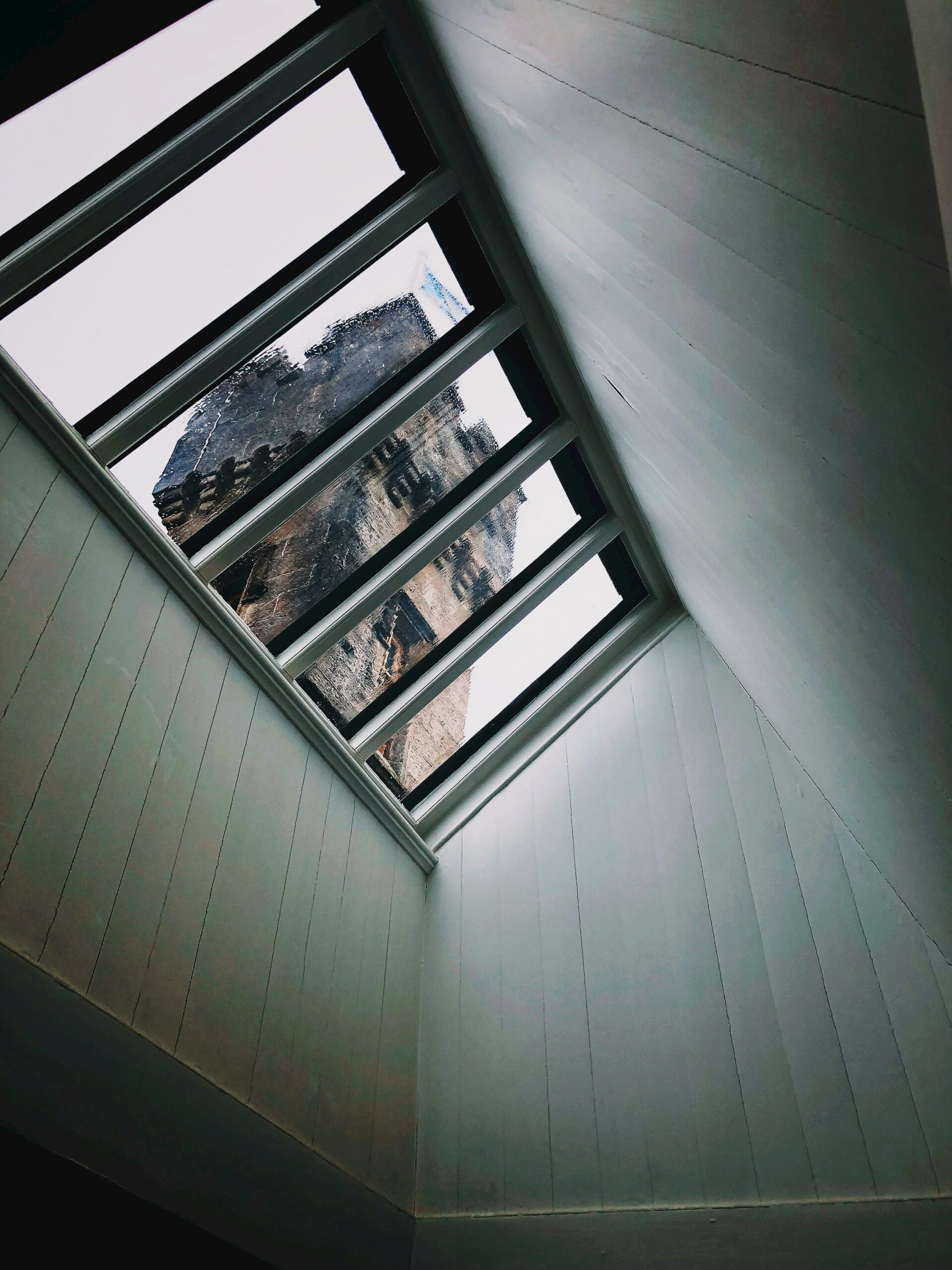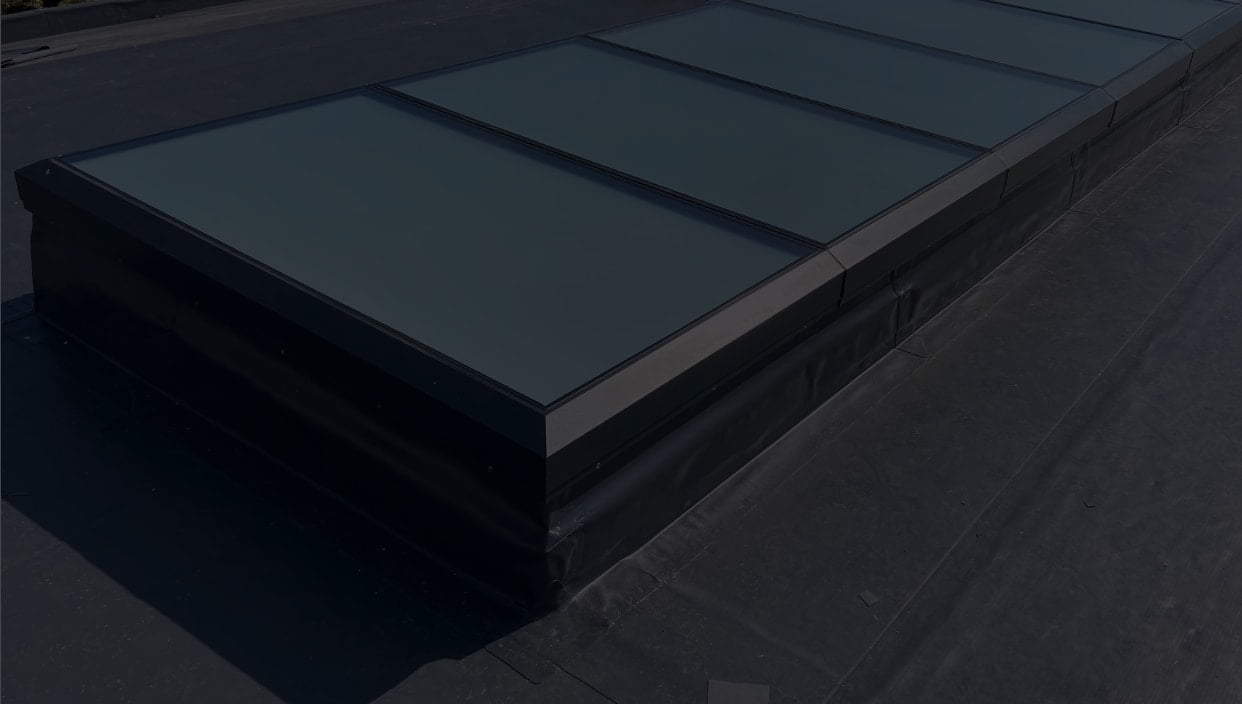
There are a range of benefits of adding skylights, roof windows, and roof lanterns to your home, including:
- Increasing the amount of light in a room
- Improving air quality and ventilation
- Increasing home value
- Design benefits
- Greater temperature control
- Privacy
- Making your room appear more spacious
- Improving energy efficiency
- Mental health benefits
Let’s look at each in more detail
Increase natural light
Adding skylights to your home lets in a lot more sunlight. This brightens up your room naturally, making it more vibrant without needing extra lights on during the day. The benefits of skylights include saving on electricity bills and enjoying a more natural setting indoors, which can make you feel happier and more energetic.
Improve air quality and ventilation
Some types of skylights can open up, allowing fresh air to flow in and stale air to flow out. This natural ventilation helps improve the air quality inside your home, getting rid of odours and reducing the buildup of humidity. This is one of the advantages of skylights, offering better ventilation and allowing your home to feel fresh. This is particularly good for kitchens and bathrooms where the air can become filled with steam or smoke. Learn why roof ventilation is important.
Increase home value
Skylights are a worthwhile investment, as they can increase the overall value of your property. Their design appeal, along with energy-saving benefits, can make your home more appealing to potential buyers, increasing its market value. They can also indirectly influence potential buyers by creating the illusion of more space in a room, and making the space generally feel more welcoming.
Design benefits
Installing a skylight in your home will make it brighter and more beautiful. They highlight your home’s design, bring out the best in colours, and make spaces feel welcoming. A skylight can transform ordinary rooms into stunning areas and add a breath of fresh air to the room – metaphorically and quite literally if you opt for a skylight that offers ventilation benefits.
Greater temperature control
Another benefit of a skylight is that you can manage your home’s temperature better. In winter, they let in sunlight that naturally warms your rooms. Some skylights can be opened to let in cool air during the summer. This control over temperature helps make your home more comfortable year-round and can even help lower your heating and cooling costs.
Privacy
Skylights can also offer light in places where you want more light but don’t want to compromise on privacy. This works great for bathrooms or bedrooms. They provide plenty of light from above without letting neighbours peek in, giving you the best of both worlds.
Make your room appear more spacious
Skylights have a unique way of making rooms look bigger. The extra light from above opens up the space, making ceilings seem higher and rooms feel wider. This is a simple trick to make your home feel more open and inviting without actually changing its size.
Improve energy efficiency and reduce bills
Skylights reduce the necessity for electrical lighting during daytime, which means you can save money on your electrical bills and help the planet by conserving energy. If your skylight is carefully positioned, you will often not need to use any electrical lighting during the daytime.
Modern skylights feature designs that save energy, including insulating qualities that help maintain indoor temperature levels. In the winter, they capture the sun’s heat to reduce the need for heating, while vented skylights in the summer allow hot air to escape, naturally cooling the house.
Mental health benefits
The positive impacts of skylights on health and wellness also have to be taken into account, with exposure to natural light linked to improved mood, enhanced sleep, and greater productivity. Skylights act as channels for sunlight, helping in the maintenance of natural body rhythms and supporting overall health.
Learn more about the benefits of natural light in the workplace, and how skylights can improve productivity in winter months.
Considerations and Tips for Skylight Installation
There are several things you should take into account before installing a skylight. Here are some of the main ones you should be thinking about.
Where to put your skylight
Choosing the right place to put your skylight is important to maximise the amount of natural light coming through, whilst avoiding having an overly warm room during the summer months. Skylights that don’t have an opening window are usually less expensive but don’t offer the same benefits in terms of ventilation or cooling.
How to choose the best skylight
When picking a skylight, think about how your house looks, what your roof is like, and what you want from the skylight – such as more light or fresh air. It’s important to look at the structural integrity of the roof you want the skylight installed, and the type of skylight you want to make sure it fits in with the rest of the house.
Outside of choosing an opening skylight or a fixed skylight, there are other features worth considering that can impact the overall cost. These include UV blocking glass, strong insulation for keeping in heat during the winter months, and rain detectors to make sure the skylight closes on its own if the weather turns bad. A skylight with less features is likely to cost less.
Learn more in our cost guide.
Tips for installing skylights
Putting in a skylight the right way is important. You should make sure qualified professionals from a reputable building or roofing firm install it to make sure it won’t leak and will keep your home warm or cool as needed.
You should also make sure your skylight meets the following requirements to make sure it meets the ‘Permitted Development’ rights – otherwise you may need planning permission.
These include:
- The skylight will not protrude more than 15cm above the roof’s plane.
- The skylight will not protrude over the roof ridge or be higher than the roof’s highest point.
- Any side-facing windows that are more than 1.7m above the ground and overlooking neighbours must be obscure-glazed.
- Any side-facing windows under 1.7m above the ground must not be able to be opened.
- No changes are made to the chimney, flue, soil or vent pipe, or solar panels.
More helpful articles:
- Roof Lanterns: Complete Guide
- Roof Windows: Complete Guide
- Rooflights vs Skylights: Complete Guide
- Ceiling Decoration Ideas
- A Guide to Single Storey Extensions
Quality rooflights from Toughened Glass Systems
We sell an impressive collection of rooflights and skylights, including:
- Roof windows
- Roof lanterns
- Circular rooflights
- Dome rooflights
- Smoke vents and access hatch rooflights
Get yours from an industry expert today, or contact us if you have any questions.
Frequently asked questions
How long do skylights last?
Typically, skylights can last upwards of 20 years if they are installed correctly and are maintained properly.
Can you leave a skylight open when it rains?
This is not recommended as water could leak into your property and potentially cause damage.
How often do skylights need maintenance?
It is recommended that skylights are inspected at least once annually, to both clean the skylight and make sure all the fixtures and fittings are not damaged.
.







